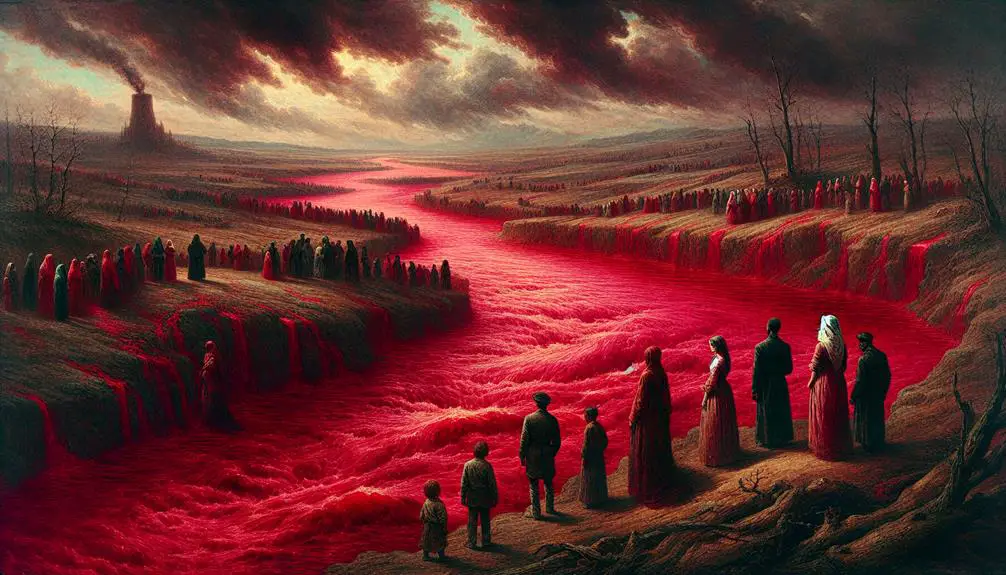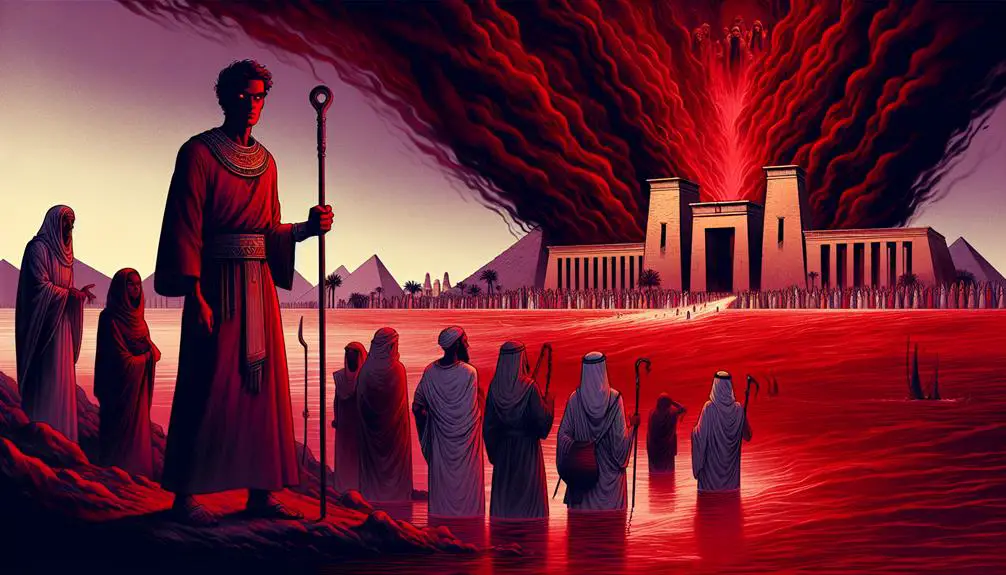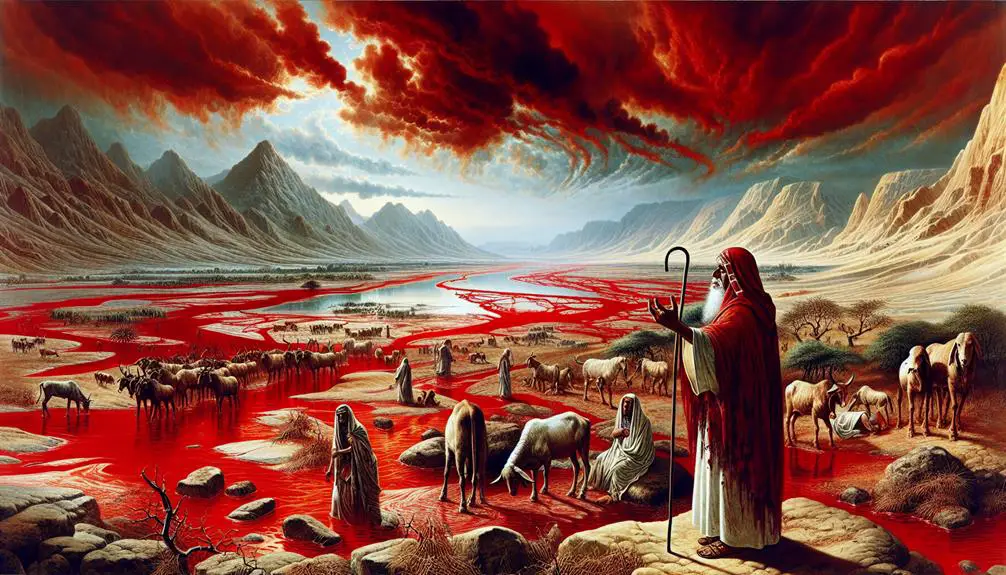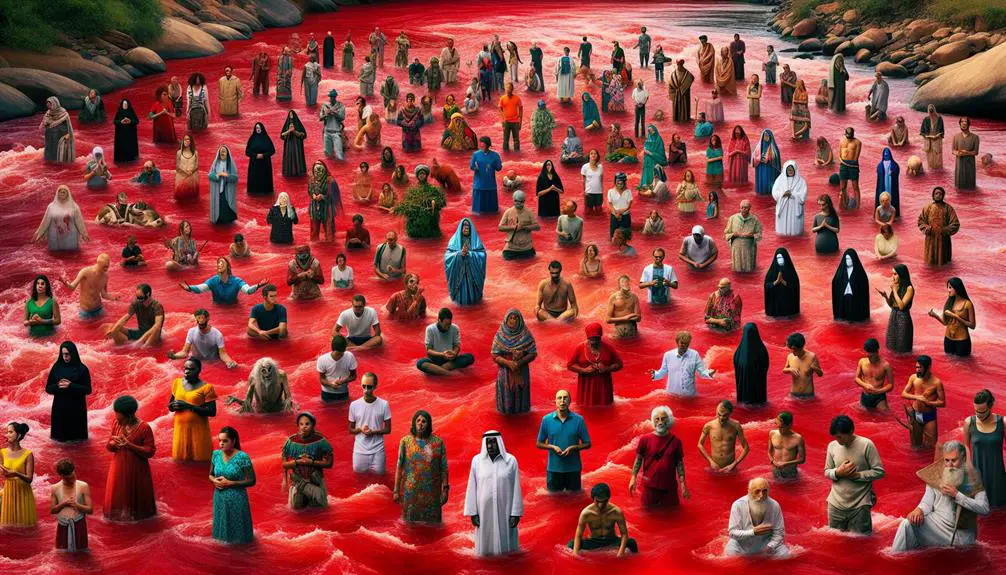Yielding profound symbolism, the biblical River of Blood narrative beckons a deeper exploration into its enigmatic and culturally significant depths.

River of Blood in the Bible
In the annals of biblical lore, the transformation of the Nile River into blood stands as a pivotal moment of divine intervention, encapsulating the struggle for liberation and the demonstration of power. This event, detailed within the Exodus narrative, not only signifies a critical juncture in the Israelites' journey from enslavement to freedom but also serves as a complex symbol open to myriad interpretations.
Spanning theological, historical, and cultural dimensions, the implications of this phenomenon extend far beyond its immediate impact, inviting a deeper exploration of its significance in both ancient and contemporary contexts. As we consider its symbolic meanings and historical underpinnings, the enduring relevance of this event becomes increasingly apparent, prompting a reevaluation of its role within broader cultural and religious discourses.
Key Takeaways
- The Nile turning into blood symbolizes divine punishment and calls for societal reflection and repentance.
- The plague highlights Moses' leadership and faith in executing divine will against Egyptian gods.
- It serves as a metaphor for environmental degradation, urging modern reflection on ecological stewardship.
- The narrative has a profound cultural impact, inspiring artistic representations and ethical debates across societies.
The Exodus Account

In the Exodus narrative, a pivotal event is the transformation of the Nile River into blood, a divine act that signifies the beginning of the ten plagues. This occurrence not only marks the commencement of a series of calamities aimed at the Egyptian oppressors but also serves as a critical point in demonstrating the mechanics of the plagues and the emergence of Moses' leadership.
The mechanics of this first plague, turning water into blood, can be analyzed from a theological perspective as a direct challenge to the Egyptian pantheon, particularly the god Hapi, who was associated with the Nile and fertility. The transformation brought immediate chaos to the Egyptian society, disrupting the water supply, killing fish, and making the river unusable for drinking or bathing. This event underscores the power dynamics at play, highlighting the supremacy of the God of Israel over Egyptian deities and nature itself.
Moses' leadership is intricately tied to the execution of the plagues. Through Moses, we see the execution of divine will, acting as the mediator between God and Pharaoh. His role is not just that of a leader but as a prophet through whom the warnings and demands of God are communicated. The plague mechanics, initiated by Moses at God's command, showcase his unwavering faith and obedience, traits that cement his leadership and guide the Israelites through their journey from slavery to freedom.
This detailed account of the first plague thus serves as a foundation for understanding the subsequent plagues, each building on the last, to demonstrate the might of God and the evolution of Moses as a leader of his people.
Symbolic Interpretations

Several symbolic interpretations have emerged regarding the transformation of the Nile into blood, each offering profound insights into the theological and socio-political underpinnings of this biblical narrative. This event, often interpreted through the lens of divine punishment, serves as a focal point for understanding the dynamics of power, faith, and retribution in ancient texts. Scholars argue that the river's transformation into blood transcends mere historical recounting, embodying a rich tapestry of apocalyptic imagery designed to convey messages of warning and moral rectitude.
The motif of apocalyptic imagery is pivotal in unpacking the layers of meaning behind this biblical phenomenon. It is posited that the transformation serves as a symbolic harbinger of cataclysmic events, reflecting the ultimate consequences of human defiance against divine will. This perspective aligns with broader theological narratives that utilize natural disasters or extraordinary occurrences as metaphors for divine punishment and the restoration of moral order.
Furthermore, the symbolic interpretation of divine punishment through the turning of the Nile into blood underscores a theological assertion of supremacy and control. It serves as a dramatic demonstration of the power wielded by the divine over the natural and political realms, challenging the perceived invincibility of earthly rulers and their gods. This act of transformation is not only a punitive measure but also a call to reflection and repentance, aiming to realign societal values and behaviors with divine expectations.
Historical Context

Understanding the symbolic interpretations of the Nile's transformation into blood necessitates an examination of the historical context within which this biblical narrative is situated. This event, as described in the Book of Exodus, not only serves as a pivotal moment in the Israelites' journey from slavery to freedom but also anchors the narrative in a specific period and location that has been the subject of extensive scholarly debate. The exploration of this historical backdrop illuminates the multifaceted layers of meaning behind the text, integrating religious symbolism with tangible historical and geographical realities.
- Geographical Debates: Scholars have engaged in debates regarding the precise locations described in the biblical narrative. The Nile, being a critical water source for Egypt, has undergone various natural and anthropogenic changes throughout history. These discussions often revolve around trying to pinpoint the exact areas affected by the described plagues, using geographical clues embedded within the text.
- Archaeological Evidence: The quest for archaeological evidence supporting the biblical account has been a central aspect of understanding the historical context. While direct evidence of such a specific event as the river turning to blood is elusive, archaeological findings have provided insight into the living conditions, natural disasters, and societal structures of ancient Egypt during the purported time frame.
- Cultural and Societal Impact: The historical context of this narrative also delves into the impact of such events on the Egyptian society and its interactions with the Israelite population. Understanding the societal norms and the political landscape of the time can offer insights into the broader implications of the plagues.
- Historical Chronology: Establishing a timeline for the events described in Exodus is crucial for placing the narrative within the broader scope of ancient Near Eastern history. Scholars use a combination of biblical, historical, and archaeological data to estimate the period during which these events might have occurred, contributing to a deeper understanding of the narrative's historical context.
Modern Reflections

Contemporary discussions surrounding the biblical narrative of the Nile turning into blood often reflect a broader discourse on its relevance and implications in today's socio-political and environmental contexts. This ancient story, while deeply rooted in religious tradition, transcends its historical setting to raise critical environmental concerns and ethical questions relevant to modern society. Scholars and environmentalists alike have drawn parallels between the biblical plague and current environmental crises, such as pollution and climate change, which threaten the health and sustainability of vital water bodies worldwide.
The narrative's symbolic representation of water turning to blood serves as a poignant metaphor for the contamination and degradation of natural resources, prompting a reevaluation of human impact on the environment. This comparison underscores the necessity for contemporary societies to adopt more sustainable practices and policies to safeguard water quality and availability for future generations.
Furthermore, the story raises ethical questions about the consequences of human actions on the environment and the moral obligations to rectify these impacts. It challenges individuals and communities to consider the long-term implications of their lifestyles and governance on ecological systems, advocating for a more responsible and ethical stewardship of the planet.
In analyzing the River of Blood narrative through a modern lens, it becomes evident that this ancient story holds significant relevance in the context of today's environmental challenges. It serves not only as a reminder of the profound interconnection between human actions and natural phenomena but also as a call to action for addressing the pressing environmental concerns and ethical dilemmas facing contemporary society.
Cultural Impact

Reflecting on the modern implications of the River of Blood narrative, it becomes crucial to explore its profound influence on cultural perceptions and values across generations. The narrative, steeped in biblical history, transcends its religious origins to impact various facets of contemporary culture. This influence is evident in:
- Artistic Representations: Artists, both classical and contemporary, have drawn inspiration from the River of Blood narrative, using it to invoke powerful imagery in paintings, literature, and digital media. These representations often explore themes of divine judgment, human morality, and the ephemeral nature of life, offering viewers and readers a space to reflect on the human condition and societal values.
- Ethical Debates: The narrative has fueled ethical debates surrounding justice, retribution, and the morality of divine intervention. Scholars and theologians grapple with the implications of the River of Blood in the context of modern ethical dilemmas, questioning the balance between divine will and human agency.
- Cultural Rituals and Traditions: Some cultures have incorporated the narrative into their rituals and traditions, using it as a metaphor for purification and renewal. These practices often symbolize the collective desire for moral and spiritual cleansing within a community.
- Educational Curricula: The River of Blood narrative is included in religious and literature curricula around the world, serving as a tool for examining historical beliefs, moral philosophy, and the interplay between myth and reality. Its inclusion encourages critical thinking and facilitates discussions on the interpretation and relevance of ancient texts in modern society.
The cultural impact of the River of Blood narrative is a testament to its enduring power and relevance, influencing artistic expression, ethical discourse, societal practices, and educational frameworks.
Frequently Asked Questions
How Have Recent Environmental Phenomena, Resembling a "River of Blood," Influenced New Interpretations or Discussions Around the Biblical Narrative?
Recent environmental phenomena, akin to a 'river of blood,' have reignited discussions on the intersection of climate symbolism and historical accuracy within biblical narratives. Scholars and theologians are increasingly exploring how these occurrences might reflect or inspire reinterpretations of scriptural events, emphasizing the analytical and scholarly investigation into the objective realities behind such symbolic representations.
This has led to a deeper understanding of the potential environmental underpinnings of ancient texts.
Are There Any Documented Health Impacts or Consequences From Historical Events That Might Have Inspired the "River of Blood" Account?
Regarding the investigation of historical events potentially linked to health impacts, medical records from antiquity do not explicitly correlate disease outbreaks with specific environmental phenomena akin to a 'river of blood'.
However, scholarly analysis suggests that such events could exacerbate existing health vulnerabilities, leading to increased instances of waterborne diseases.
This objective perspective necessitates a deeper examination of environmental and health archives to fully understand the implications of these occurrences on public health.
How Have Different Religious Traditions Outside of Judaism and Christianity Interpreted or Referenced the "River of Blood" Concept in Their Teachings or Texts?
The concept of a 'river of blood' has found resonance within various religious traditions beyond its origination. Islamic interpretations, for instance, often emphasize metaphorical or allegorical readings of such phenomena, reflecting on moral or eschatological themes.
Hindu mythology, conversely, integrates this imagery into narratives illustrating cosmic or divine retributions. These diverse interpretations underscore the motif's universal appeal, serving as a profound symbol for conveying moral or theological lessons across different cultural contexts.
What Are the Scientific Explanations or Theories Behind the Natural Occurrences That Could Resemble a "River of Blood" and How Have These Been Viewed or Reconciled With Religious Beliefs?
Scientific explanations for phenomena resembling a 'river of blood' primarily relate to red tide causes and algal bloom effects. These natural occurrences result from the proliferation of certain algae species, leading to water discoloration.
Analyzing these events from a scholarly and objective perspective reveals a complex interplay between environmental factors and biological responses. Reconciling these scientific understandings with religious beliefs involves acknowledging the diverse interpretations and symbolic meanings attributed to such phenomena across cultures.
Can the "River of Blood" Narrative Be Found in Any Contemporary Fictional Works or Popular Media, and How Has It Influenced the Portrayal of Similar Apocalyptic Themes?
The narrative of a 'river of blood' has permeated contemporary fictional works and popular media, serving as a potent symbol of apocalyptic themes. This motif, rich in literary symbolism, often represents the culmination of cataclysmic events, embodying societal fears and existential anxieties.
Its use in various narratives not only underscores the enduring influence of apocalyptic representation in literature and film but also reflects a deep-seated fascination with the end times and their implications for humanity.
Conclusion
In conclusion, the narrative of the river of blood, as depicted in the Exodus account, serves not only as a historical recounting of events but also as a rich source of symbolic interpretation. Despite criticisms regarding its historical accuracy, this narrative undeniably holds a significant place in cultural and religious discourse.
It challenges modern readers to reflect on the themes of liberation, divine judgment, and the enduring power of faith, thus cementing its relevance across generations and cultures.



Sign up